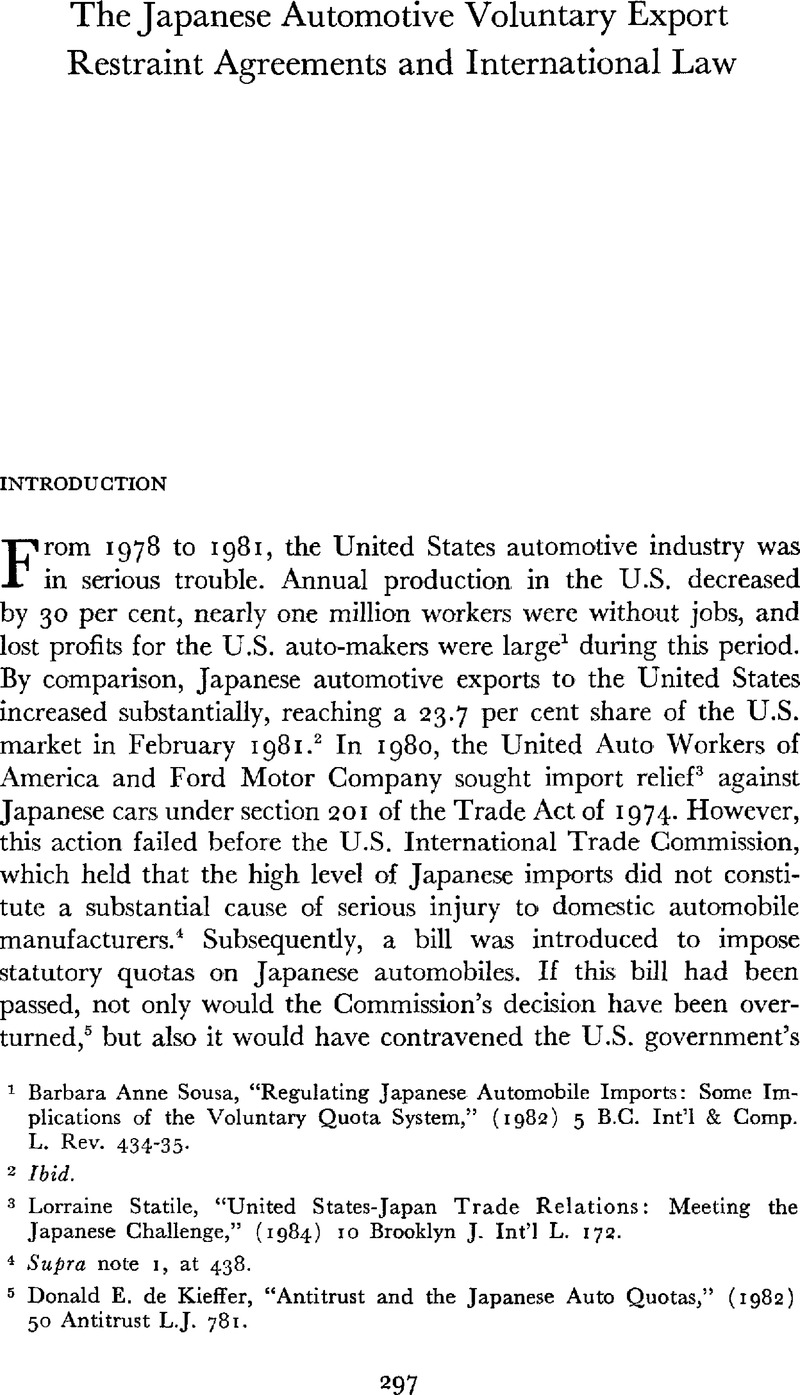No CrossRef data available.
Published online by Cambridge University Press: 09 March 2016

1 Sousa, Barbara Anne, “Regulating Japanese Automobile Imports: Some Implications of the Voluntary Quota System,” (1982) 5 B.C. Int’l & Comp. L. Rev. 434–35.Google Scholar
2 Ibid.
3 Statile, Lorraine, “United States-Japan Trade Relations: Meeting the Japanese Challenge,” (1984) 10 Brooklyn J. Int’l L. 172.Google Scholar
4 Supra note 1, at 438.
5 de Kieffer, Donald E., “Antitrust and the Japanese Auto Quotas,” (1982) 50 Antitrust L.J. 781.Google Scholar
6 Supra note 1, at 438.
7 Supra note 5, at 782.
8 Leo, Robert J., “An Update of the Japanese Automobile Export Restraint,” (1982) 8 Brooklyn J. Int’l L. 159–60.Google Scholar
9 Supra note 5, at 788.
10 Globe and Mail (Toronto), Mar. 30, 1985, at B-1, col. 1.
11 Austen, Ian, “Strong Measures for Automakers,” Maclean’s, May 30, 1983, at 31.Google Scholar
12 Langdon, Frank, The Politics of Canadian-J apáñese Economic Relations, 1952-1983 48 (Vancouver, 1983).Google Scholar
13 Ibid., 51.
14 Ibid., 52.
15 Fleming, James, “The Fight over Import Quotas,” Maclean’s, May 28, 1984, at 46.Google Scholar
16 Ibid.
17 Supra note 10. On July 3, 1985, an understanding was reached between Canada and Japan. Since this understanding is merely an informal arrangement between these two countries, it is not clear whether it is a complete renewal of the expired agreement. See the statements made by the Honourable Sinclair Stevens, Minister of Regional Industrial Expansion, and the Honourable James Kelleher, Minister of State for International Trade, entitled “Japanese Car Imports” (July 3, 1985).
18 Metzger, Stanley D., Lowering Non Tariff Barriers 145 (Washington, D.C., 1974).Google Scholar
19 Supra note 3, at 172.
20 Langdon, op. cit. supra note 12, at 51.
21 Supra note 8, at 172.
22 GATT, Mar. 1969, 4 Basic Instruments and Selected Documents 2.
23 Dam, Kenneth W., The GATT: Law and International Economic Organization 150 (Chicago, 1970).Google Scholar
24 Supra note 5, at 787–89.
25 Allison, Gary D., “The Non Tariff Trade Barrier Challenge: Development and Distortion in the Age of Interdependence,” (1976) 12 Tulsa L.J. 28.Google Scholar
26 Supra note 3, at 172.
27 Dam, op. cit. supra note 23, at 151.
28 Ibid.
29 Langdon, op. cit. supra note 12, at 50.
30 Dam, op. cit. supra note 23, at 99.
31 Supra note 1, at 442.
32 Merciai, Patrizio, “Safeguard Measures in GATT,” (1981) 15 J.W.T.L. 44.Google Scholar
33 Sarna, A. J., “Safeguards against Market Disruption — The Canadian View,” (1976) 10 J.W.T.L. 356.Google Scholar
34 GATT, Mar. 1970, Analytical Index (3rd rev.) 107.
35 Supra note 33, at 357.
36 Supra note 1, at 442.
37 Ibid.
38 JAMA Canada, Comments on the Motor Vehicle and Parts Industry Task Force Report 6 (Toronto, 1983).
39 Ibid.
40 Dam, op. cit. supra note 23, at 102.
41 Ibid.
42 Ibid., 104.
43 Langdon, op. cit. supra note 12, at 50.
44 Farless, Nada J., “GATT and the Tokyo Round: Legal Implications of the New Trade Agreement,” (1981) 11 Cal. Western Int’l L.J. 321.Google Scholar
45 Victoria Curzon Price, “Surplus Capacity and What the Tokyo Round Failed to Settle,” (1979) 2 The World Economy 310.
46 Wetzel, Ralf Gunter and Rauschning, Dietrich, The Vienna Convention on the Law of Treaties 48 (Frankfurt, 1978).Google Scholar
47 Akehursr, Michael, A Modern Introduction to International Law 121 (4th ed., London, 1982).Google Scholar
48 Wetzel and Rauschning, op. cit. supra note 46, at 213.
49 Sinclair, Ian, The Vienna Convention on the Law of Treaties 84 (2nd ed., Manchester, 1984).Google Scholar
50 Wetzel and Rauschning, op. cit. supra note 48.
51 Ibid.
52 Stanford, J. S., “The Vienna Convention on the Law of Treaties,” (1970) 20 U. of T.L.J. 32.CrossRefGoogle Scholar